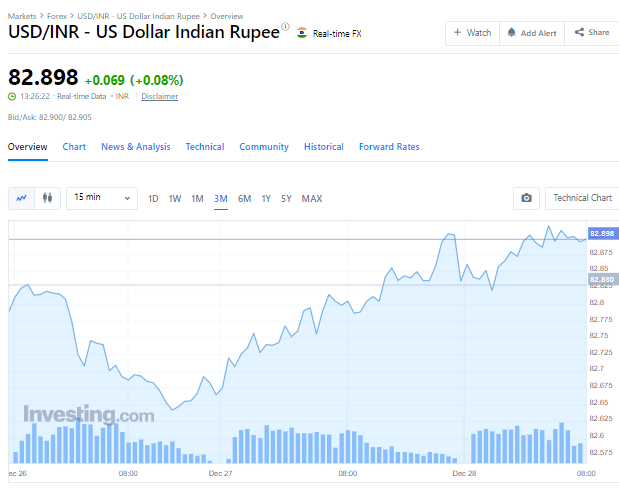
The US Dollar stands at INR 82.82 as of today.
Ever wonder why the Rupee always depreciates against the Dollar?
Let’s find out in a 🧵:
#USD #Dollar #forex #investing
Ever wonder why the Rupee always depreciates against the Dollar?
Let’s find out in a 🧵:
#USD #Dollar #forex #investing

One of the major reasons for INR depreciation is India’s massive exposure and dependence on one single commodity:
OIL.
Almost 70% of our imports in value is just crude oil, as we’re the third-largest consumer globally.
There are two ways this affect our economy and currency.
OIL.
Almost 70% of our imports in value is just crude oil, as we’re the third-largest consumer globally.
There are two ways this affect our economy and currency.
1. Global crude oil market is denominated in USD.
This means we have to sell INR to buy USD in the Forex market first, and then pay the same to OPEC to import oil.
As demand for USD rises, and supply being controlled by The Fed, its value too rises against the INR.
#oilprices
This means we have to sell INR to buy USD in the Forex market first, and then pay the same to OPEC to import oil.
As demand for USD rises, and supply being controlled by The Fed, its value too rises against the INR.
#oilprices
In addition to oil, most international transactions are also settled in USD thereby shooting up its demand for other goods and services.
This is the main reason why India is trying to move away from the hegemony of the dollar and trying out Rupee transactions globally.
#Fed
This is the main reason why India is trying to move away from the hegemony of the dollar and trying out Rupee transactions globally.
#Fed
2. Over dependence on oil imports makes INR vulnerable, affects Balance of Payments.
Imagine having a currency and economy that’s fragile to the price movement of just one commodity: it brings down its value by default.
In addition, having a high import bill that cannot be
Imagine having a currency and economy that’s fragile to the price movement of just one commodity: it brings down its value by default.
In addition, having a high import bill that cannot be
balanced by our exports means that India has a large current account deficit (CAD).
A large CAD is considered a negative and results in lower foreign investment.
For e.g., China has a current account surplus due to a high manufacturing base, resulting in a stronger Yuan.
A large CAD is considered a negative and results in lower foreign investment.
For e.g., China has a current account surplus due to a high manufacturing base, resulting in a stronger Yuan.
A lower foreign investment means that there’s a lower demand for INR.
Why?
Because higher foreign #investment in India require the FIIs to convert their USD to INR to #invest which would increase the demand (and hence value) of the Rupee.
#investing #StockMarket
Why?
Because higher foreign #investment in India require the FIIs to convert their USD to INR to #invest which would increase the demand (and hence value) of the Rupee.
#investing #StockMarket
As our dependence on oil reduces and our exports start rising, both the above factors will slowly neutralise.
Once that happens INR will start strengthening against the USD 🔥🔥
But remember, INR weakening is not always bad (will be covered in another 🧵).
#IndianEconomy
Once that happens INR will start strengthening against the USD 🔥🔥
But remember, INR weakening is not always bad (will be covered in another 🧵).
#IndianEconomy
This was a simplified lesson on currency valuation!
There’s more to it, but if you enjoyed it consider liking and RT the first tweet so others can learn something new today!
You may also follow me and check out my podcast 💰The Money Memo 💰here: anchor.fm/ajayinvests
There’s more to it, but if you enjoyed it consider liking and RT the first tweet so others can learn something new today!
You may also follow me and check out my podcast 💰The Money Memo 💰here: anchor.fm/ajayinvests
• • •
Missing some Tweet in this thread? You can try to
force a refresh





